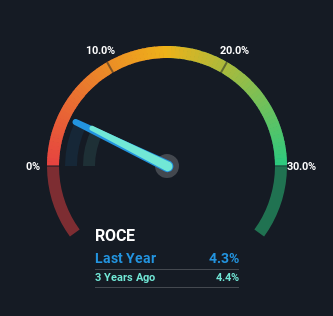- United States
- /
- Water Utilities
- /
- NYSE:WTRG
Essential Utilities (NYSE:WTRG) Has Some Way To Go To Become A Multi-Bagger

Did you know there are some financial metrics that can provide clues of a potential multi-bagger? Firstly, we'd want to identify a growing return on capital employed (ROCE) and then alongside that, an ever-increasing base of capital employed. Put simply, these types of businesses are compounding machines, meaning they are continually reinvesting their earnings at ever-higher rates of return. Having said that, from a first glance at Essential Utilities (NYSE:WTRG) we aren't jumping out of our chairs at how returns are trending, but let's have a deeper look.
Return On Capital Employed (ROCE): What Is It?
For those who don't know, ROCE is a measure of a company's yearly pre-tax profit (its return), relative to the capital employed in the business. To calculate this metric for Essential Utilities, this is the formula:
Return on Capital Employed = Earnings Before Interest and Tax (EBIT) ÷ (Total Assets - Current Liabilities)
0.043 = US$701m ÷ (US$17b - US$679m) (Based on the trailing twelve months to March 2024).
Therefore, Essential Utilities has an ROCE of 4.3%. Even though it's in line with the industry average of 4.3%, it's still a low return by itself.
View our latest analysis for Essential Utilities

Above you can see how the current ROCE for Essential Utilities compares to its prior returns on capital, but there's only so much you can tell from the past. If you'd like to see what analysts are forecasting going forward, you should check out our free analyst report for Essential Utilities .
What The Trend Of ROCE Can Tell Us
The returns on capital haven't changed much for Essential Utilities in recent years. Over the past five years, ROCE has remained relatively flat at around 4.3% and the business has deployed 146% more capital into its operations. This poor ROCE doesn't inspire confidence right now, and with the increase in capital employed, it's evident that the business isn't deploying the funds into high return investments.
The Bottom Line On Essential Utilities' ROCE
As we've seen above, Essential Utilities' returns on capital haven't increased but it is reinvesting in the business. And investors may be recognizing these trends since the stock has only returned a total of 11% to shareholders over the last five years. As a result, if you're hunting for a multi-bagger, we think you'd have more luck elsewhere.
One more thing: We've identified 4 warning signs with Essential Utilities (at least 1 which is potentially serious) , and understanding these would certainly be useful.
While Essential Utilities isn't earning the highest return, check out this free list of companies that are earning high returns on equity with solid balance sheets.
Valuation is complex, but we're here to simplify it.
Discover if Essential Utilities might be undervalued or overvalued with our detailed analysis, featuring fair value estimates, potential risks, dividends, insider trades, and its financial condition.
Access Free AnalysisHave feedback on this article? Concerned about the content? Get in touch with us directly. Alternatively, email editorial-team (at) simplywallst.com.
This article by Simply Wall St is general in nature. We provide commentary based on historical data and analyst forecasts only using an unbiased methodology and our articles are not intended to be financial advice. It does not constitute a recommendation to buy or sell any stock, and does not take account of your objectives, or your financial situation. We aim to bring you long-term focused analysis driven by fundamental data. Note that our analysis may not factor in the latest price-sensitive company announcements or qualitative material. Simply Wall St has no position in any stocks mentioned.
Have feedback on this article? Concerned about the content? Get in touch with us directly. Alternatively, email editorial-team@simplywallst.com
About NYSE:WTRG
Essential Utilities
Through its subsidiaries, operates regulated utilities that provide water, wastewater, and natural gas services in the United States.
Solid track record average dividend payer.
Similar Companies
Market Insights
Community Narratives


